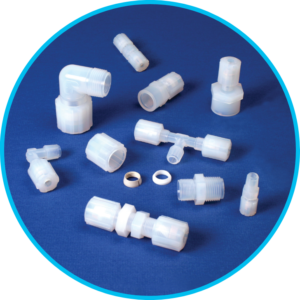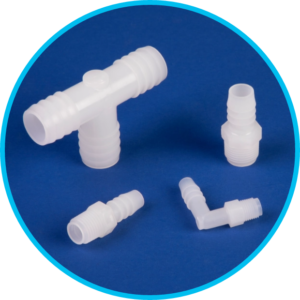Not all fittings for plastic tubing and hose are created equally. There are many different fitting materials and styles, each with multiple, practical uses and with uses for which they are not recommended. Here we’ll address some misconceptions about fittings available from NewAge Industries.
Myth 1: Fittings are always easy to attach.
As a general rule, yes, they’re easy to attach. But improper fitting installations can lead to leaks, so be sure they’re attached to your tubing, reinforced hose, or other equipment correctly.
While it’s true that some fittings like push-to-connects are quite simple to install – push the tubing into the fitting, pull back on the tubing to secure – they work best with rigid and semi-rigid tubing cut cleanly and at a 90° angle. Barbed fittings are also easy to install, although the proper technique should be used when inserting the fitting into the tubing. The fitting must be twisted back and forth during insertion and not screwed into the tubing in one direction. Doing so can cause a groove to develop on the I.D. of the tubing, offering a leak potential. Barbed fittings typically need cable ties or clamps (the proper style and size, of course) for secure attachment to tubing and hose. These must be placed in the right spot and tightened but not over tightened. (See our fitting installation videos for more tips.)
 Compression fittings contain multiple parts that need to be assembled onto the tubing in the right order and orientation. Like push-to-connect fittings, they work best with tubing cut cleanly and at a 90° angle. Cam operated couplings are available with barbed or threaded ends. Those with barbed ends require clamps for proper attachment to a hose. Threaded end couplings are threaded into a piece of equipment or another fitting, and thread sealant may be needed.
Compression fittings contain multiple parts that need to be assembled onto the tubing in the right order and orientation. Like push-to-connect fittings, they work best with tubing cut cleanly and at a 90° angle. Cam operated couplings are available with barbed or threaded ends. Those with barbed ends require clamps for proper attachment to a hose. Threaded end couplings are threaded into a piece of equipment or another fitting, and thread sealant may be needed.
Myth 2: All fittings can be reused.
Plastic fittings … perhaps, but it’s subject to their prior usage (are the fittings dirty and in need of cleaning, or were they damaged during a previous use?). Metal fittings … it depends. If it’s a durable, metal push-to-connect or barbed fitting, it’s likely reusable, although a barbed fitting would need to be taken apart from the assembly. Any cable ties or clamps would need to be removed and the fitting pulled from the tubing or hose. The cost and time of the labor to do this should be considered, as it may be more cost effective to simply replace the assembly.
Compression fittings can be disassembled and reused, but some interior components (a gripper or ferrule) may need to be replaced. Crimped-on fittings are typically not reusable, as threads can be damaged during the assembly process.
Myth 3: Fittings are just an add-on and not all that important.
Not true! The fitting style and material can be just as critical as the tubing style and material. For instance, you typically wouldn’t use PVC hose for an application involving temperatures above 175°F, just as you typically wouldn’t use a nylon barbed fitting for such temperatures – neither product is designed to handle that temperature, although many other tubing and fitting materials and styles are.
Myth 4: Fittings are the cheapest way to connect tubing and hose.
Not always – consider molded connections. Although their upfront cost tends to be higher than separate tubing, fittings, and clamps or cable ties, their dependability to prevent leaks can be a cost saver in the long run. Just imagine the repercussions of a multi-million-dollar batch of biopharmaceutical product leaking from a fitting-to-tubing connection … the wasted money, the time delays, the added labor and resources, the environmental risks. Some tubing materials (thermoplastic elastomer, for example) can be welded, eliminating the need for fittings altogether.
We’re happy to answer your questions about fittings – give us a call at 215-526-2300 or complete the following form.


